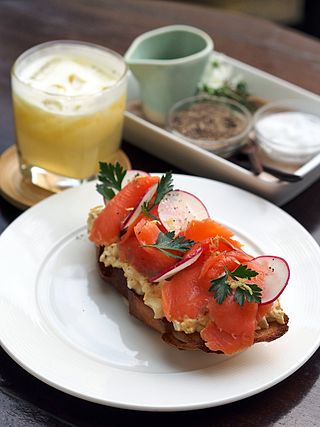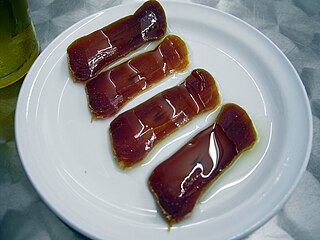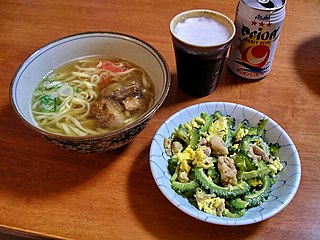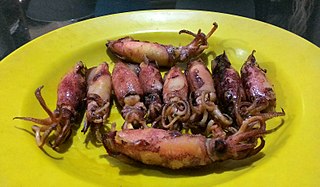Related Research Articles

Miso is a traditional Japanese seasoning. It is a thick paste produced by fermenting soybeans with salt and kōji and sometimes rice, barley, seaweed, or other ingredients. It is used for sauces and spreads, pickling vegetables, fish, or meats, and mixing with dashi soup stock to serve as miso soup, a Japanese culinary staple. Miso is high in protein and rich in vitamins and minerals, and it played an important nutritional role in feudal Japan. Miso is still widely used in both traditional and modern cooking in Japan and has been gaining worldwide interest.

Salting is the preservation of food with dry edible salt. It is related to pickling in general and more specifically to brining also known as fermenting and is one form of curing. It is one of the oldest methods of preserving food, and two historically significant salt-cured foods are salted fish and salt-cured meat. Vegetables such as runner beans and cabbage are also often preserved in this manner.

Smoked salmon is a preparation of salmon, typically a fillet that has been cured and hot or cold smoked.

Roe or hard roe is the fully ripe internal egg masses in the ovaries, or the released external egg masses, of fish and certain marine animals such as shrimp, scallop, sea urchins and squid. As a seafood, roe is used both as a cooked ingredient in many dishes, and as a raw ingredient for delicacies such as caviar.

The history of sushi began with paddy fields, where fish was fermented with vinegar, salt and rice, after which the rice was discarded. The earliest form of the dish, today referred to as narezushi, was created in Japan around the Yayoi period. In the Muromachi period (1336–1573), people began to eat the rice as well as the fish. During the Edo period (1603–1867), vinegar rather than fermented rice began to be used. The dish has become a form of food strongly associated with Japanese culture.

Zigong, formed by the merger of the two former towns of Ziliujing and Gongjing, is a prefecture-level city in Sichuan, southwestern China.

Pickling is the process of preserving or extending the shelf life of food by either anaerobic fermentation in brine or immersion in vinegar. The pickling procedure typically affects the food's texture and flavor. The resulting food is called a pickle, or, to prevent ambiguity, prefaced with pickled. Foods that are pickled include vegetables, fruits, meats, fish, dairy and eggs.

Puffed rice and popped rice are types of puffed grain made from rice commonly eaten in the traditional cuisines of Southeast Asia, East Asia, and South Asia. It has also been produced commercially in the West since 1904 and is popular in breakfast cereals and other snack foods.

Kusaya (くさや) is a salted, dried and fermented fish that is produced in the Izu Islands, Japan. It has a pungent smell and is similar to the fermented Swedish herring surströmming.

Mojama is a Mediterranean delicacy consisting of filleted salt-cured tuna, typically found in the Murcia and Andalusia regions of Spain, particularly in Huelva and Cádiz. Bluefin or yellowfin tuna are the most common varieties used.

Fresh fish rapidly deteriorates unless some way can be found to preserve it. Drying is a method of food preservation that works by removing water from the food, which inhibits the growth of microorganisms. Open air drying using sun and wind has been practiced since ancient times to preserve food. Water is usually removed by evaporation but, in the case of freeze-drying, food is first frozen and then the water is removed by sublimation. Bacteria, yeasts and molds need the water in the food to grow, and drying effectively prevents them from surviving in the food.

Okinawan cuisine is the cuisine of the Okinawa Prefecture of Japan. The cuisine is also known as Ryūkyūan cuisine, a reference to the Ryukyu Kingdom. Due to differences in culture, historical contact between other regions, climate, vegetables and other ingredients, Okinawan cuisine differs from mainland Japanese cuisine.

Open-pan salt making is a method of salt production wherein salt is extracted from brine using open pans.

Salted fish, such as kippered herring or dried and salted cod, is fish cured with dry salt and thus preserved for later eating. Drying or salting, either with dry salt or with brine, was the only widely available method of preserving fish until the 19th century. Dried fish and salted fish are a staple of diets in the Caribbean, West Africa, North Africa, South Asia, Southeast Asia, Southern China, Scandinavia, parts of Canada including Newfoundland, coastal Russia, and in the Arctic. Like other salt-cured meats, it provides preserved animal protein even in the absence of refrigeration.

Anchovies are small, common saltwater forage fish in the family Engraulidae that are used as human food and fish bait. There are 144 species in 17 genera found in the Atlantic, Indian, and Pacific Oceans. Anchovies are usually classified as oily fish. They are small, green fish with blue reflections due to a silver longitudinal stripe that runs from the base of the caudal fin. They range from 2 centimetres (0.79 in) to 40 centimetres (16 in) in adult length, and the body shape is variable, with more slender fish in northern populations.

This article traces the history of cuisine of Japan. Foods and food preparation by the early Japanese Neolithic settlements can be pieced together from archaeological studies, and reveals paramount importance of rice and seafood since early times.

The harvesting and consuming of seafoods are ancient practices that may date back to at least the Upper Paleolithic period which dates to between 50,000 and 10,000 years ago. Isotopic analysis of the skeletal remains of Tianyuan man, a 40,000-year-old modern human from eastern Asia, has shown that he regularly consumed freshwater fish. Archaeology features such as shell middens, discarded fish bones and cave paintings show that sea foods were important for survival and consumed in significant quantities. During this period, most people lived a hunter-gatherer lifestyle and were, of necessity, constantly on the move. However, where there are early examples of permanent settlements such as those at Lepenski Vir, they are almost always associated with fishing as a major source of food.

Cantonese salted fish is a traditional Chinese food originating from Guangdong province. It is a fish preserved or cured with salt, and was a staple food in Guangdong. It historically earned the nickname of the "poor man's food", as its extreme saltiness is useful in adding variety to the simpler rice-based dinners. Cantonese salted fish was revealed to be on the list of Group 1 known carcinogens, but was suspected and studied for its links to cancer as early as the 1960s due to the high incidence of nasopharyngeal cancer, an extremely rare type of nose and head cancer now understood to be linked to a high consumption of this dish.

Salted squid is squid or cuttlefish cured with dry salt and thus preserved for later consumption. Drying or salting, either with dry salt or with brine is a widely available method of seafood preservation. Salted squid is often mistaken with dried shredded squid, which is specifically shredded and seasoned dried squid. The salted squid production method is similar to salted fish and often considered as a specific variant of salted fish. Salted squid commonly found in coastal Asian countries, especially Indonesia, Malaysia, Thailand, Vietnam, Taiwan, Hong Kong, Southern China, South Korea and Japan.
References
- ↑ Sang (2017-04-06). "Himono: Cutting, Drying and Grilling Fish The Japanese Way". Knifeplanet. Retrieved 2022-10-31.
- 1 2 "Numazu's Himono, Born of Craftsmanship, and Secret Brine". SHUNGATE. Retrieved 2022-10-31.
- ↑ "Himono | Traditional Saltwater Fish Dish From Japan | TasteAtlas". www.tasteatlas.com. Retrieved 2022-10-31.
- 1 2 3 "Japanese Culture in the Kitchen | Himono - Tasty Sun-dried Fish". web-japan.org. Retrieved 2022-10-31.
- ↑ Jones, Roger (2018-07-26). "Japanese Himono (salted, dried fish)". Japan Eight. Retrieved 2022-10-31.
- 1 2 Itoh, Makiko (2015-11-20). "Before Japan ate raw fish, there was himono". The Japan Times. Retrieved 2022-10-31.